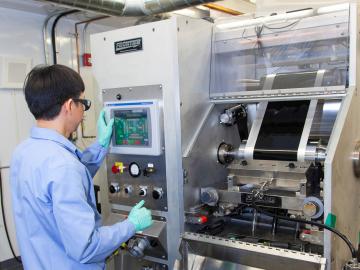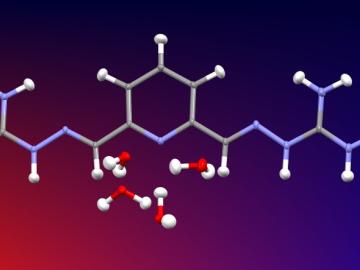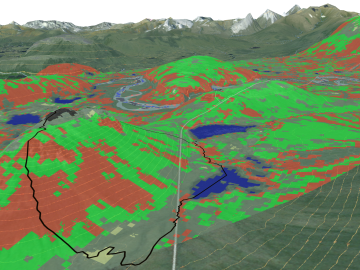
Filter News
Area of Research
- (-) Energy Science (122)
- (-) Isotopes (8)
- (-) Neutron Science (51)
- Advanced Manufacturing (2)
- Biological Systems (1)
- Biology and Environment (123)
- Biology and Soft Matter (1)
- Building Technologies (1)
- Computational Biology (2)
- Computational Engineering (3)
- Computer Science (15)
- Electricity and Smart Grid (3)
- Energy Frontier Research Centers (1)
- Functional Materials for Energy (1)
- Fusion and Fission (13)
- Fusion Energy (8)
- Materials (104)
- Materials for Computing (13)
- Mathematics (1)
- National Security (37)
- Nuclear Science and Technology (16)
- Nuclear Systems Modeling, Simulation and Validation (1)
- Quantum information Science (7)
- Sensors and Controls (2)
- Supercomputing (137)
News Topics
- (-) Advanced Reactors (6)
- (-) Biomedical (26)
- (-) Computer Science (35)
- (-) Environment (60)
- (-) Grid (39)
- (-) Nanotechnology (17)
- (-) Physics (10)
- (-) Security (8)
- (-) Summit (9)
- 3-D Printing/Advanced Manufacturing (83)
- Artificial Intelligence (14)
- Big Data (7)
- Bioenergy (31)
- Biology (18)
- Biotechnology (5)
- Buildings (38)
- Chemical Sciences (17)
- Clean Water (10)
- Composites (18)
- Coronavirus (22)
- Critical Materials (9)
- Cybersecurity (9)
- Energy Storage (75)
- Exascale Computing (2)
- Fossil Energy (3)
- Frontier (3)
- Fusion (2)
- High-Performance Computing (8)
- Hydropower (3)
- Irradiation (1)
- Isotopes (26)
- Machine Learning (10)
- Materials (50)
- Materials Science (49)
- Mathematics (3)
- Mercury (3)
- Microelectronics (1)
- Microscopy (10)
- Molten Salt (1)
- National Security (8)
- Neutron Science (121)
- Nuclear Energy (12)
- Partnerships (12)
- Polymers (12)
- Quantum Computing (1)
- Quantum Science (8)
- Simulation (4)
- Space Exploration (9)
- Statistics (1)
- Transportation (68)
Media Contacts

OAK RIDGE, Tenn., March 20, 2019—Direct observations of the structure and catalytic mechanism of a prototypical kinase enzyme—protein kinase A or PKA—will provide researchers and drug developers with significantly enhanced abilities to understand and treat fatal diseases and neurological disorders such as cancer, diabetes, and cystic fibrosis.

Higher carbon dioxide levels caused 30 percent more wood growth in young forest stands across the temperate United States over a decade, according to an analysis led by Oak Ridge National Laboratory.

The use of lithium-ion batteries has surged in recent years, starting with electronics and expanding into many applications, including the growing electric and hybrid vehicle industry. But the technologies to optimize recycling of these batteries have not kept pace.

Researchers used neutron scattering at Oak Ridge National Laboratory’s Spallation Neutron Source to investigate the effectiveness of a novel crystallization method to capture carbon dioxide directly from the air.

Oak Ridge National Laboratory scientists have created open source software that scales up analysis of motor designs to run on the fastest computers available, including those accessible to outside users at the Oak Ridge Leadership Computing Facility.

A team of scientists led by Oak Ridge National Laboratory used machine learning methods to generate a high-resolution map of vegetation growing in the remote reaches of the Alaskan tundra.
![Coexpression_hi-res_image[1].jpg Coexpression_hi-res_image[1].jpg](/sites/default/files/styles/list_page_thumbnail/public/Coexpression_hi-res_image%5B1%5D_0.jpg?itok=ww635BCP)
While studying the genes in poplar trees that control callus formation, scientists at Oak Ridge National Laboratory have uncovered genetic networks at the root of tumor formation in several human cancers.

A team of scientists has for the first time measured the elusive weak interaction between protons and neutrons in the nucleus of an atom. They had chosen the simplest nucleus consisting of one neutron and one proton for the study.

To learn more about interactions between drug molecules and micelles, Associate Professor Megan Robertson and graduate students Tyler Cooksey and Tzu-Han Li from the University of Houston (UH) are using neutrons at the Department of Energy’s (DOE’s) Oak Ridge National Laboratory (ORNL).


